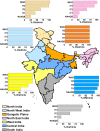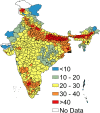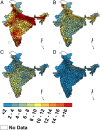Indian annual ambient air quality standard is achievable by completely mitigating emissions from household sources
- PMID: 30988190
- PMCID: PMC6561163
- DOI: 10.1073/pnas.1900888116
Indian annual ambient air quality standard is achievable by completely mitigating emissions from household sources
Abstract
Exposures to ambient and household fine-particulate matter (PM2.5) together are among the largest single causes of premature mortality in India according to the Global Burden of Disease Studies (GBD). Several recent investigations have estimated that household emissions are the largest contributor to ambient PM2.5 exposure in the country. Using satellite-derived district-level PM2.5 exposure and an Eulerian photochemical dispersion model CAMx (Comprehensive Air Quality Model with Extensions), we estimate the benefit in terms of population exposure of mitigating household sources--biomass for cooking, space- and water-heating, and kerosene for lighting. Complete mitigation of emissions from only these household sources would reduce India-wide, population-weighted average annual ambient PM2.5 exposure by 17.5, 11.9, and 1.3%, respectively. Using GBD methods, this translates into reductions in Indian premature mortality of 6.6, 5.5, and 0.6%. If PM2.5 emissions from all household sources are completely mitigated, 103 (of 597) additional districts (187 million people) would meet the Indian annual air-quality standard (40 μg m-3) compared with baseline (2015) when 246 districts (398 million people) met the standard. At 38 μg m-3, after complete mitigation of household sources, compared with 55.1 μg m-3 at baseline, the mean annual national population-based concentration would meet the standard, although highly polluted areas, such as Delhi, would remain out of attainment. Our results support expansion of programs designed to promote clean household fuels and rural electrification to achieve improved air quality at regional scales, which also has substantial additional health benefits from directly reducing household air pollution exposures.
Keywords: PM2.5; air pollution; cooking; heating; lighting.
Conflict of interest statement
The authors declare no conflict of interest.
Figures





Comment in
-
Toward cleaner air for a billion Indians.Proc Natl Acad Sci U S A. 2019 May 28;116(22):10614-10616. doi: 10.1073/pnas.1905458116. Epub 2019 May 17. Proc Natl Acad Sci U S A. 2019. PMID: 31101719 Free PMC article. No abstract available.
References
Publication types
LinkOut - more resources
Full Text Sources
Miscellaneous

